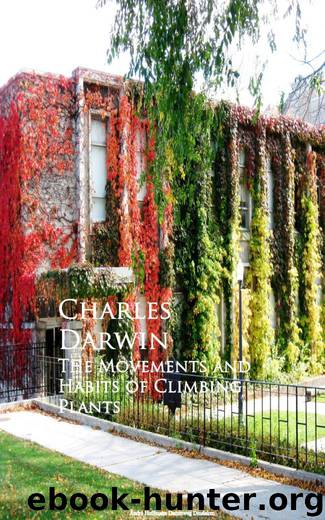The Movements and Habits of Climbing Plants by Charles Darwin

Author:Charles Darwin [Darwin, Charles]
Language: eng
Format: epub
Published: 2016-08-07T00:00:00+00:00
Smilaceæ.— Smilax aspera, var. maculata.—Aug. St.-Hilaire [118] considers that the tendrils, which rise in pairs from the petiole, are modified lateral leaflets; but Mohl (p. 41) ranks them as modified stipules. These tendrils are from 1½ to 1¾ inches in length, are thin, and have slightly curved, pointed extremities. They diverge a little from each other, and stand at first nearly upright. When lightly rubbed on either side, they slowly bend to that side, and subsequently become straight again. The back or convex side when placed in contact with a stick became just perceptibly curved in 1 hr. 20 m., but did not completely surround it until 48 hrs. had elapsed; the concave side of another became considerably curved in 2 hrs. and clasped a stick in 5 hrs. As the pairs of tendrils grow old, one tendril diverges more and more from the other, and both slowly bend backwards and downwards, so that after a time they project on the opposite side of the stem to that from which they arise. They then still retain their sensitiveness, and can clasp a support placed behind the stem. Owing to this power, the plant is able to ascend a thin upright stick. Ultimately the two tendrils belonging to the same petiole, if they do not come into contact with any object, loosely cross each other behind the stem, as at B, in fig. 7. This movement of the tendrils towards and round the stem is, to a certain extent, guided by their avoidance of the light; for when a plant stood so that one of the two tendrils was compelled in thus slowly moving to travel towards the light, and the other from the light, the latter always moved, as I repeatedly observed, more quickly than its fellow. The tendrils do not contract spirally in any case. Their chance of finding a support depends on the growth of the plant, on the wind, and on their own slow backward and downward movement, which, as we have just seen, is guided, to a certain extent, by the avoidance of the light; for neither the internodes nor the tendrils have any proper revolving movement. From this latter circumstance, from the slow movements of the tendrils after contact (though their sensitiveness is retained for an unusual length of time), from their simple structure and shortness, this plant is a less perfect climber than any other tendril-bearing species observed by me. The plant whilst young and only a few inches in height, does not produce any tendrils; and considering that it grows to only about 8 feet in height, that the stem is zigzag and is furnished, as well as the petioles, with spines, it is surprising that it should be provided with tendrils, comparatively inefficient though these are. The plant might have been left, one would have thought, to climb by the aid of its spines alone, like our brambles. As, however, it belongs to a genus, some of the species of which are
Download
This site does not store any files on its server. We only index and link to content provided by other sites. Please contact the content providers to delete copyright contents if any and email us, we'll remove relevant links or contents immediately.
| Fossils | Game Theory |
| Genetics | Molecular Biology |
| Organic | Paleontology |
Sapiens: A Brief History of Humankind by Yuval Noah Harari(13037)
Sapiens by Yuval Noah Harari(4528)
Homo Deus: A Brief History of Tomorrow by Yuval Noah Harari(4272)
Pale Blue Dot by Carl Sagan(3995)
Origin Story: A Big History of Everything by David Christian(3133)
Livewired by David Eagleman(3113)
Brief Answers to the Big Questions by Stephen Hawking(2872)
Inferior by Angela Saini(2829)
Origin Story by David Christian(2677)
The Evolution of Beauty by Richard O. Prum(2550)
Signature in the Cell: DNA and the Evidence for Intelligent Design by Stephen C. Meyer(2496)
The Gene: An Intimate History by Siddhartha Mukherjee(2488)
Aliens by Jim Al-Khalili(2376)
How The Mind Works by Steven Pinker(2206)
Sex at Dawn: The Prehistoric Origins of Modern Sexuality by Ryan Christopher(2148)
From Bacteria to Bach and Back by Daniel C. Dennett(2146)
A Short History of Nearly Everything by Bryson Bill(2131)
Endless Forms Most Beautiful by Sean B. Carroll(2079)
Who We Are and How We Got Here by David Reich(2057)
